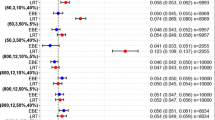Abstract
Purpose. The aim of this work was a pragmatic, statistically sound and clinically relevant approach to dose-proportionality analyses that is compatible with common study designs.
Methods. Statistical estimation is used to derive a (1-α)% confidence interval (CI) for the ratio of dose-normalized, geometric mean values (Rdnm) of a pharmacokinetic variable (PK). An acceptance interval for Rdnm defining the clinically relevant, dose-proportional region is established a priori. Proportionality is declared if the CI for Rdnm is completely contained within the critical region. The approach is illustrated with mixed-effects models based on a power function of the form PK = β0 • Doseβ1; however, the logic holds for other functional forms.
Results. It was observed that the dose-proportional region delineated by a power model depends only on the dose ratio. Furthermore, a dose ratio (ρ1) can be calculated such that the CI lies entirely within the pre-specified critical region. A larger ratio (ρ2) may exist such that the CI lies completely outside that region. The approach supports inferences about the PK response that are not constrained to the exact dose levels studied.
Conclusion. The proposed method enhances the information from a clinical dose-proportionality study and helps to standardize decision rules.
Similar content being viewed by others
REFERENCES
J. D. Haynes and A. I. Weiss. Modeling pharmacokinetic dose-proportionality data. Proceed. Biopharm. Section Amer. Stat. Assoc. 85–89 (1989).
L. Yuh, M. G. Eller, and S. J. Ruberg. A stepwise approach for analyzing dose proportionality studies. Proceed. Biopharm. Section Amer. Stat. Assoc. 47–50 (1990).
H. I. Patel. Dose-response in pharmacokinetics. Commun. Statist.-Theory Meth. 23:451–465 (1994).
K. Gough, M. Hutchison, O. Keene, B. Byrom, S. Ellis, L. Lacey, and J. McKellar. Assessment of dose proportionality: Report from the statisticians in the pharmaceutical industry/pharmacokinetics UK joint working party. Drug Info. J. 29:1039–1048 (1995).
J. T. Lettieri, M. C. Rogge, L. Kaiser, R. M. Echols, and A. H. Heller. Pharmacokinetic profiles of ciprofloxacin after single intravenous and oral doses. Antimicrob. Agents Chemother. 36:993–996 (1992).
W. Cawello, A. Leonhardt, H. Schweer, H. W. Seyberth, R. Bonn, and A. L. Lomeli. Dose proportional pharmacokinetics of alprostadil (prostaglandin E1) in healthy volunteers following intravenous infusion. Br. J. Clin. Pharmacol. 40:273–276 (1995).
D. R. Brocks, A. W. Meikle, S. C. Boike, N. A. Mazer, N. Zariffa, P. R. Audet, and D. K. Jorkasky. Pharmacokinetics of Testosterone in hypogonadal men after transdermal delivery: Influence of dose. J. Clin. Pharmacol. 36:732–739 (1996).
T. M. Ludden, D. A. Boyle, D. Gieseker, G. T. Kennedy, M. H. Crawford, L. K. Ludden, and W. A. Clement. Absolute bioavailability and dose proportionality of betaxolol in normal healthy subjects. J. Pharm. Sci. 77:779–782 (1988).
K. J. Klamerus, K. Maloney, R. L. Rudolph, S. F. Sisenwine, W. J. Jusko, and S. T. Chiang. Introduction of a composite parameter to the pharmacokinetics of Venalfaxine and its active O-desmethyl metabolite. J. Clin. Pharmacol. 32:716–724 (1992).
M.-L. Chen and R. Patnaik. Statistical Procedures for Bioequivalence Studies Using a Standard Two-Treatment Crossover Design. Division of Bioequivalence, Office of Generic Drugs, Food and Drug Administration 1992.
D. J. Finney. Statistical Method in Biological Assay, Third Edition, Charles Griffin & Company Ltd, London, 1978.
J. G. Wagner. Properties of the Michaelis-Menton equation and its integrated form which are useful in pharmacokinetics. J. Pharmacokin. Biopharm. 1:103–120 (1973).
N. P. Chau. Area-dose relationships in nonlinear models. J. Pharmacokin. Biopharm. 4:537–551 (1976).
T. A. Sheppard, N. Lordi, and P. E. Sparrow. Influence of dose range on degree of nonlinearity detected in dose-proportionality studies for drugs with saturable elimination: single-dose and steady-state studies. Pharm. Res. 10:289–293 (1993).
Author information
Authors and Affiliations
Rights and permissions
About this article
Cite this article
Smith, B.P., Vandenhende, F.R., DeSante, K.A. et al. Confidence Interval Criteria for Assessment of Dose Proportionality. Pharm Res 17, 1278–1283 (2000). https://doi.org/10.1023/A:1026451721686
Issue Date:
DOI: https://doi.org/10.1023/A:1026451721686




